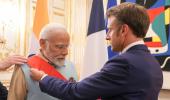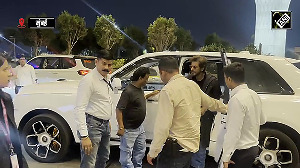Officials hint the visit could finally see a formal defence industrial road map being adopted by both nations.

French President Emmanuel Macron's surprise Republic Day visit shapes a strategic rendezvous as France becomes the linchpin of India's defence, space, and nuclear ambitions.
On Friday, January 26, 2024, Macron will be the fifth French president to attend the Republic Day celebrations as chief guest.
Officials say the visit makes sense, given how crucial France has become to India's defence, space, and civil nuclear plans.
Macron had been in India for the G20 summit in September.
After a luncheon meeting with Prime Minister Narendra Modi, the only visiting leader to have done so, he announced unanimous support for India's G20 agenda.
Modi had been guest of honour at the Bastille Day Parade on July 14 in Paris.
During the visit, both countries signed the Horizon 2047 road map, marking the 25th anniversary of the India-France strategic partnership.
The road map further strengthened a strategic move by both countries to come together in the Asia-Pacific region (APAC).
A commitment to 'work together to secure their own economic and security interests' in the region, by creating a bulwark against Chinese influence in the region, the plan has also led to investments from France now beginning to reach India in higher numbers, officials said.
According to the French embassy in India, more than 600 French subsidiaries with over 1,000 offices and facilities from a wide spectrum of sectors are already present in India and employ about 400,000 people.
In terms of trade, France has historically lagged behind other large European economies such as Germany, and the UK, or even smaller ones such as the Netherlands and Switzerland.
As of the ongoing financial year, France is only India's 23rd largest trade partner.
But since the pandemic in 2020, shipments have risen. Pushed up by petroleum exports, the trade balance has turned in India's favour.
But the largest chunk of trade remains in a sector without any public data.
Officials hint the visit could finally see a formal defence industrial road map being adopted by both nations.
Under negotiation for the past years, the policy could catapult Indian defence producers into the global league by allowing them access to European technology and exposure to France's list of clients in APAC and beyond.
A long-term buyer of defence equipment from Russia, New Delhi has turned towards other players such as France and Israel to modernise its arsenal in recent years.
India had first ordered a batch of 36 Rafale multi-role fighter jets from France in 2016, all of which have been delivered between July 2020 and April 2022.
Manufactured by Dassault Aviation, the jets have garnered support from the Air Force despite the controversy over their selection and purchase.
In July, the government gave initial approval for an order of 26 additional Rafale jets for the Indian Navy and six Scorpene submarines.
The flurry of defence orders from India has bolstered France's position as the world's third-largest arms exporter, behind the US and Russia.
Between 2018 and 2022, France's share of the global arms trade increased to 11 per cent compared with 7.1 per cent over the previous four-year period, according to an annual Stockholm International Peace Research Institute report published in March.
However, defence purchases have given way to France becoming one of India's key partners in the development of a self-reliant defence industrial and technological base.
Memoranda of understanding signed between defence public sector undertakings of both countries have stood out for their tall goal of manufacturing submarines and warships in the docks of Mumbai and Kolkata for export to third countries.
France has also allowed its defence major Safran to jointly design, develop, test, manufacture, and certify an engine with Hindustan Aeronautics to power India's twin-engine advanced combat aircraft and the twin-engine deck-based fighter for Indian aircraft carriers.
They also decided to support industrial cooperation for the motorisation of heavy-lift helicopters under the Indian Multi-Role Helicopter programme with Safran Helicopter Engines.
From atom to space
In July, both countries agreed to speed up talks on the Jaitapur nuclear plant project.
With an installed capacity of 9.6 gigawatt electrical, the proposed plant in Maharashtra's Ratnagiri district would be the most powerful nuclear power plant globally.
It would meet the annual consumption needs of 70 million households and restrict an estimated 80 million tonnes of carbon dioxide emissions annually.
Meanwhile, work on space is taking off.
France's national space agency -- the National Centre for Space Studies -- and the Indian Space Research Organisation have created an Indo-French working group on India's human spaceflight mission Gaganyaan.
Sources also hinted that the French space agency may get to test key propulsion technology that Gaganyaan is dependent upon.
In 2019, India chose Ukraine as the testing ground for its Rs 1,800 crore (Rs 18 billion) semi-cryogenic engine (SCE-200), considered a huge technological leap as it is expected to enhance the carrying capacity of Isro's geosynchronous satellite launch vehicle (GSLV) Mark III (Mk III) rocket from 4 tonnes to 7.5 tonnes.
However, reports have emerged that the Ukrainian facility may have been damaged during the ongoing Russia-Ukraine war.
With the GSLV MkIII rocket being crucial in propelling the first three Indian astronauts to low earth orbit for an extended time, the government may give the testing mandate to France.


Feature Presentation: Aslam Hunani/Rediff.com












 © 2025
© 2025